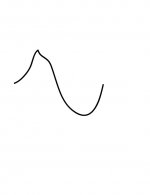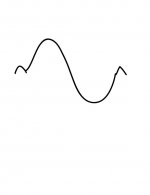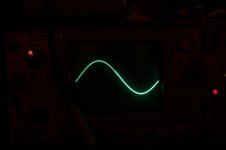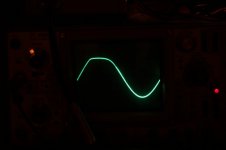Hi,
I have a Fender M-80 Bass Amp which is having problems with distortion at the output.
I've traced the sound (by ear), which occurs past a certain point in the circuit (after the 'Effect Send' jack. The 'Effect Send' jack output is comparatively clean.). The 'Line Out' jack is cleaner without the speaker load, but is very distorted with the speaker load. The 'Effect Send' is not affected by speaker load and remains clean.
I've scoped the various test points, and, whereas the points up through TP6 show a clean sine wave; thereafter, the wave takes on a shape like this (please excuse my Illustrator art approximations - below). I'm not sure if this wave shape is a characteristic of this type of circuit or not.
(distorted sine wave a.jpg)
At the output, the clipping is evident in the wave:
(distorted sine wave b.jpg)
I appreciate any input or suggestions about likely culprits, etc. The last time I tested, I had narrowed down the distortion in the area of Q8 (2SC2362K) transistor, but that was just a hunch.
Attached is the schematic for this amp.
Thanks again,
Louis
I have a Fender M-80 Bass Amp which is having problems with distortion at the output.
I've traced the sound (by ear), which occurs past a certain point in the circuit (after the 'Effect Send' jack. The 'Effect Send' jack output is comparatively clean.). The 'Line Out' jack is cleaner without the speaker load, but is very distorted with the speaker load. The 'Effect Send' is not affected by speaker load and remains clean.
I've scoped the various test points, and, whereas the points up through TP6 show a clean sine wave; thereafter, the wave takes on a shape like this (please excuse my Illustrator art approximations - below). I'm not sure if this wave shape is a characteristic of this type of circuit or not.
(distorted sine wave a.jpg)
At the output, the clipping is evident in the wave:
(distorted sine wave b.jpg)
I appreciate any input or suggestions about likely culprits, etc. The last time I tested, I had narrowed down the distortion in the area of Q8 (2SC2362K) transistor, but that was just a hunch.
Attached is the schematic for this amp.
Thanks again,
Louis
Attachments
Here are scope shots of test point 15 (tp15).
Image A: no clipping, and Image B: when it just starts to clip.
The clipping is only on the top part of the wave.
Image A:
Image B:
Image A: no clipping, and Image B: when it just starts to clip.
The clipping is only on the top part of the wave.
Image A:
An externally hosted image should be here but it was not working when we last tested it.
Image B:
An externally hosted image should be here but it was not working when we last tested it.
What's on TP7 when TP15 is distorted? If you plug into efx return what do you get on TP15? Plugging into the return will point you to the preamp or the power amp.
I know this has been on going for quite some time on Audiokarma but I didn't want get involved with everyone else.
Craig
I know this has been on going for quite some time on Audiokarma but I didn't want get involved with everyone else.
Craig
Some basics I learned years ago.
1. Always test without a load when first starting to troubleshoot.
2. If the output is good without a load everything up to and including the drivers is OK.
3. If the output is bad with a load the output stage is bad provided #1 is OK.
BUT there are going to be some oddball circumstances where this may not apply.
Craig
1. Always test without a load when first starting to troubleshoot.
2. If the output is good without a load everything up to and including the drivers is OK.
3. If the output is bad with a load the output stage is bad provided #1 is OK.
BUT there are going to be some oddball circumstances where this may not apply.
Craig
If R114 is open circuit due to failure of the one transistor, excess voltage on the positive cycle will operate the short circuit protector Q17 and cause this effect, as could a faulty C59, causing HT lag. If there is no load, I gather there is no problem on the output so as Craig mentioned, the drivers are OK, so it must be an output problem.
With no load, R114 will have no voltage drop. Is the quiescent current correct?
With no load, R114 will have no voltage drop. Is the quiescent current correct?
1) What level do we have at TP15 when it starts to top clip?Here are larger, clickable versions of the scope waves from today's earlier posting.
Will respond more fully when I have a chance to look at those other test points.
Thanks
You don't say.
That's the last preamp stage, then it drives the power amp.
About 500mV there is all that's required (as shown in the TP15 description).
If it clips at, say, above 5 or 6 V RMS "then you don't have a problem"
2) you will always find weird signals at the collectors of Q8, Q9, Q11, Q13, base of Q16, etc. because the "differential input pair" Q8-Q9 are all day long comparing the speaker out signal to the input one, detecting the difference, and sending that error signal through the amp so output transistors produce what's expected.
It's called an "error signal" and contains what the output waveform is missing.
3) I suggest you drive the power amp to clipping, with load; if you get somewhat around 22-24 VAC into 4 ohms, amp is doing fine.
If not, post slightly clipping output waveform and measured power/voltage and we'll see.
Also measure needed drive signal to get that.
Hey Jon,
There has been an on going thread about this particular amp over on Audiokarma, it's lllloooonnnngggg. So I'm starting fresh with the troubleshooting here with this 5 minute problem. If we confirm the no load/load problem it may well be something in the VI limiter circuit.
Craig
There has been an on going thread about this particular amp over on Audiokarma, it's lllloooonnnngggg. So I'm starting fresh with the troubleshooting here with this 5 minute problem. If we confirm the no load/load problem it may well be something in the VI limiter circuit.
Craig
That is what I just said. Current limiting or poor power supply.Hey Jon,
There has been an on going thread about this particular amp over on Audiokarma, it's lllloooonnnngggg. So I'm starting fresh with the troubleshooting here with this 5 minute problem. If we confirm the no load/load problem it may well be something in the VI limiter circuit.
Craig

Some basics I learned years ago.
1. Always test without a load when first starting to troubleshoot.
2. If the output is good without a load everything up to and including the drivers is OK.
3. If the output is bad with a load the output stage is bad provided #1 is OK.
BUT there are going to be some oddball circumstances where this may not apply.
Craig
Thanks everyone for the great input! I will address this first. I've been testing without a load to get these readings, with the distorted output.
What's on TP7 when TP15 is distorted? If you plug into efx return what do you get on TP15? Plugging into the return will point you to the preamp or the power amp.
I know this has been on going for quite some time on Audiokarma but I didn't want get involved with everyone else.
Craig
TP7's level seems quite high. The schematic says '473mV,' whereas in measuring with a scope set at 1V/div, it's around 3V, with somewhat squashed peaks of the wave. When the Delta Comp is switched 'on,' then the level is reduced, roughly to 2V.
Here (below) is TP19, when I feed the sine wave into the 'return' jack.
Attachments
MY '66 Fender Bassman has Audible distortions.
It's seriously desirable... Because of it's legendary/cherished Distortion
Why is it considered a problem ?
If your Bassman developed a new distortion in addition to the one you love, would you not think it was a problem?
I agree with Juan though, he does need to determine if the levels are problematic or just flawed expectations.
Thanks. Yes, I know about desirable distortion, but this is a jarring type that weakens the signal. E.G. when you play harder, instead of becoming louder, the sound remains quiet and fuzzy, kinda like a cat.
Last edited:
Dear buck110x , my Argentine Colleague, elnaldo, already gave you the proper answer at audiokarma: what you see is the effect of Fender's cheesy "Deltacomp", period, doing what it's supposed to do.
It's an assymetrical clipper.
On positive peaks, it will clip at= 4.95 V peak, or 3.5V RMS
On negative peaks= 2.8V peak or 1.98V ... or the 2V RMS you measured.
Not a problem at all, that asymmetrical clipper (not compressor at all) is there to add "grind" to an otherwise very clean Bass amp, ... what many find "boring".
So in a nutshell: "you do not have a problem" .
If that distortion annoys you, just turn Deltacomp off.
The power amp still has a good limiter built around U6 , a CA3080 .
WAIT A MINUTE: they are activating *both* with the same switch ... are they crazy?
Personal suggestions:
1) disable cheesy clipper by cutting the track leading from S1a pin 1 to U4b pin 7 .
*IF* you wish to enable it to play some Jack Bruce riffs, drill the front panel and add a small switch, like those used in guitars for phase splitting, etc. to switch it on and off.
so you can use desirable normal compression/limiting based on CA3080
or:
2) leave the good compression *always* on, by shorting S1B legs 2 and 3.
If in doubt, short all 3 legs with a small piece of wire, it's the same.
FAHEY motto: "SS Bass amps can NOT be used without Compression/Limiting"
Period.
Try it and post results.
And go back to Audiokarma and tell Elnaldo that he was right
It's an assymetrical clipper.
On positive peaks, it will clip at= 4.95 V peak, or 3.5V RMS
On negative peaks= 2.8V peak or 1.98V ... or the 2V RMS you measured.
Not a problem at all, that asymmetrical clipper (not compressor at all) is there to add "grind" to an otherwise very clean Bass amp, ... what many find "boring".
So in a nutshell: "you do not have a problem" .
If that distortion annoys you, just turn Deltacomp off.
The power amp still has a good limiter built around U6 , a CA3080 .
WAIT A MINUTE: they are activating *both* with the same switch ... are they crazy?
Personal suggestions:
1) disable cheesy clipper by cutting the track leading from S1a pin 1 to U4b pin 7 .
*IF* you wish to enable it to play some Jack Bruce riffs, drill the front panel and add a small switch, like those used in guitars for phase splitting, etc. to switch it on and off.
so you can use desirable normal compression/limiting based on CA3080
or:
2) leave the good compression *always* on, by shorting S1B legs 2 and 3.
If in doubt, short all 3 legs with a small piece of wire, it's the same.
FAHEY motto: "SS Bass amps can NOT be used without Compression/Limiting"
Period.
Try it and post results.
And go back to Audiokarma and tell Elnaldo that he was right
Let me state it this way: whether Delta Comp is on or off, the sound is still weak and distorted. The harder a string is plucked, the more mutated the sound becomes.
This is very different than 'desirable' or 'effect' distortion or 'fuzz.'
No amplifier operates like this in its normal state.
This is very different than 'desirable' or 'effect' distortion or 'fuzz.'
No amplifier operates like this in its normal state.
- Status
- This old topic is closed. If you want to reopen this topic, contact a moderator using the "Report Post" button.
- Home
- Live Sound
- Instruments and Amps
- Fender M-80 Bass Amp / distorted output




